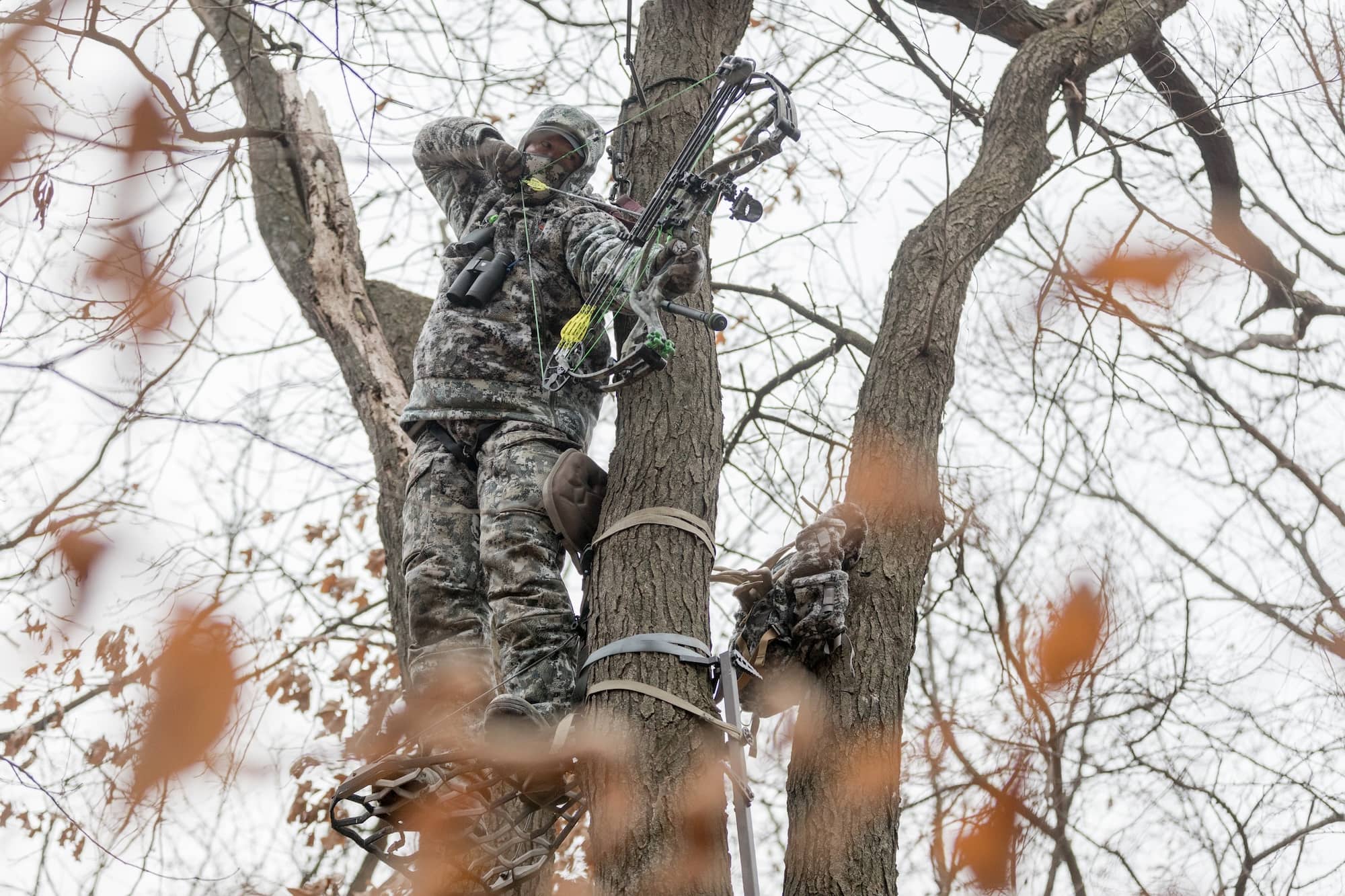When a buck steps into my shooting lane during the rut, it’s easy to think I just got lucky. But luck isn’t what puts venison in my freezer year after year.
What separates consistent hunters from the rest isn’t fancy gear or even shooting ability. It’s the methodical way they create high-percentage shot opportunities through strategic stand placement and habitat manipulation.
After decades of hunting pressured deer across the country, I’ve refined my tree stand setup process to a science. Today, I’ll explain how I create what I consider the perfect stand location, using one of my favorite rut spots as the blueprint.
The Silent Approach: Engineering Your Access Route
The first kill-factor for any stand setup isn’t the tree itself. It’s how you get there without announcing your presence to every deer in the county. Eliminate your imprint!
My go-to hunting spot is a thick bedding area just 70–80 yards from a road. Most hunters would write this spot off as “too close to pressure,” but that accessibility becomes an advantage when you engineer it correctly.
I mowed a deliberate path to this spot that winds into the thick cover super silently. This isn’t just convenient; it’s tactical.
Every crunchy leaf, every snapping twig, every noise-making obstacle has been eliminated. With a simple lawnmower pass or a garden rake two weeks before the season, I created a silent highway straight to my ambush point.
You’ve gotta have a quiet entrance and a quiet exit. This single factor ruins more hunts than any other.
You don’t need a lawnmower: a rake or weed eater works just as well. The point is creating a path where you can move silently, regardless of conditions. When other hunters are crashing through the woods at 5 a.m., I’m gliding to my stand undetected.
Positioning for Success: The Three Non-Negotiables
As I reach my stand location after walking that silent path, three factors determine my stand placement:
1. Wind Direction Is Everything
I set up my stand for north and northwest winds, which carry my scent away from the deer travel corridor and bedding area. Ideally, your wind will blow back along the same path you used to enter, so the only area that gets “burned out” with scent and tracks is your silent access route.
Many hunters place stands in locations that only work with perfect wind conditions that rarely materialize. I’m ruthlessly practical: I position stands for the predominant winds I’ll encounter during my planned hunting periods.
This stand is a dedicated rut setup for those cold November fronts that typically bring north winds.
2. Back Cover Breaks Your Outline
Find something that gives you back cover. For instance, the dense cedar branches I like to keep behind my stand break up my silhouette.
Many hunters spend time “brushing in” the front of their setup. That’s certainly helpful, but if you’re completely skylined with nothing behind you, your movement will still be noticeable. Back cover and shade are the most important elements.
Without this natural backdrop, you’re skylined against the bright horizon: a dead giveaway to approaching deer. The thick cedar provides a dark background that conceals my movement when I’m repositioning for a shot.
I’ve kept my stand height moderate too, staying within the cover rather than above it. Going too high often puts you above your concealment, which defeats the purpose. Stay in the cover.
3. Sun Position Creates Natural Advantage
The low morning sun is positioned strategically behind my stand. If a buck approaches my stand, senses something, and looks up, it’ll look right into the sun.
This natural blinding effect gives me an edge. It’s saved countless hunts when bucks might otherwise pick me off.
The formula is straightforward: Wind in your face plus sun at your back equals a freezer full of venison.
Engineering Deer Movement
A perfect stand doesn’t just conceal the hunter. It manipulates deer’s movement to create high-percentage shot opportunities.
Standing in front of my go-to tree, I can point to several small stumps where I’ve cut trees to create shooting lanes. That way, I can get about 30 or 40 yards of shot opportunities.
But the real magic is in extending that mowed path down into that bedding area. The cleared trail bypasses my stand at exactly 20 yards — perfect bow range.
Deer, like humans, follow the path of least resistance. By creating easy travel routes through otherwise thick cover, I’ve built a highway system that funnels deer exactly where I want them. The key is making these modifications subtle enough that they appear natural yet still effectively direct movement.
My motto: Rake it, and they’ll take it. Big bucks like stealth too!
These routes connect bedding areas with natural funnels. This is easy travel. Bucks follow does; does run from the bucks.
The Shooting Setup: Comfort Equals Accuracy
Stand orientation is important for making ethical, comfortable shots. I position my stand facing the clearing, but angled slightly so that my primary shooting lane is to my left front — my prime shooting zone.
This positioning allows me to shoot without standing up. That’s a huge advantage when deer appear suddenly during the rut. Every unnecessary movement increases your chance of getting busted.
I position my stand to accommodate a camera arm on a secondary tree to my right — perfect for self-filming hunts. If you’re not filming, this consideration for equipment placement matters for backpacks, rangefinders, and other gear you’ll use during the hunt.
Verification Through Reconnaissance
Finally, no stand setup is complete without confirmation that deer are using the area. I’ve positioned my Stealth Cam trail camera to monitor the funnel I’ve created. Stealth Cam’s reliability in harsh outdoor conditions makes it my go-to choice for confirming deer patterns.

I’ve already gotten pictures of bucks here. This verification process confirms I’ve picked the right spot and helps me time my hunts for peak deer movement.
Bringing It All Together
The perfect stand location isn’t one magical tree. It’s a spot where you can systematically control every variable you can and adapt to those you can’t.
The perfect stand location combines:
- Silent entrance and exit routes
- Favorable wind direction
- Natural back cover for concealment
- Strategic sun positioning
- Engineered deer movement
- Comfortable shooting position
- Verified deer activity through scouting
The beauty is that these principles apply whether you’re hunting private or public land, big woods or small woodlots.
So, before you hang your next stand, take the time to engineer not just a good setup, but the perfect ambush. In bowhunting, those high-percentage opportunities fill tags season after season.






 massmonopoly
massmonopoly